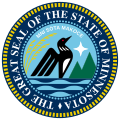2026 Minnesota Senate election
| |||||||||||||||||||||||||
All 67 seats in the Minnesota Senate 34 seats needed for a majority | |||||||||||||||||||||||||
|---|---|---|---|---|---|---|---|---|---|---|---|---|---|---|---|---|---|---|---|---|---|---|---|---|---|
| |||||||||||||||||||||||||
 Map of the incumbents: DFL incumbent DFL incumbent retiring Republican incumbent Republican incumbent retiring Seat vacant | |||||||||||||||||||||||||
| |||||||||||||||||||||||||
| Elections in Minnesota |
|---|
 |
The 2026 Minnesota Senate election will take place on November 3, 2026. All 67 districts in the Minnesota Senate will be up for election to a four-year term. Primary elections will be held on August 11, 2026.[1] Currently, 33 seats are held by DFLers, 32 seats are held by Republicans, and two seats, formerly held by a Republican and a Democrat respectively, are vacant.
The election will coincide with the election of the State House of Representatives as well as various federal, state, and local elections.
Background
[edit]The last election in 2022 resulted in the Minnesota Democratic-Farmer-Labor Party attaining a majority in the chamber for the first time since 2012, gaining the DFL a trifecta from 2023 until 2025.[2] As Minnesota Senate seats follow a 2,4,4 term length schedule, there was no regularly scheduled Minnesota Senate election in 2024.[3][4]
Outgoing members
[edit]Retiring
[edit]- Jim Carlson (DFL–Eagan), representing district 52 since 2022,[a] is retiring.[5]
- Jeremy Miller (R–Winona), representing district 26 since 2022,[b] is retiring.[6]
- Ann Rest (DFL–New Hope), representing district 43 since 2022,[c] is retiring.[7]
Seeking other office
[edit]- Matt Klein (DFL–Mendota Heights), representing district 53 since 2022,[d] is running for the U.S. House of Representatives.[8]
- Eric Pratt (R–Prior Lake), representing district 54 since 2022,[e] is running for the U.S. House of Representatives.[9]
Fundraising
[edit]| Campaign finance reports as of December 31, 2024[f] | |||
|---|---|---|---|
| Committee | Raised | Spent | Cash on hand |
| Senate Victory Fund (R)[10] | $1,151,807 | $826,553 | $1,562,937 |
| DFL Senate Caucus[11] | $2,753,880 | $1,467,168 | $2,164,135 |
| Source: Minnesota Campaign Finance Board[12] | |||
Notes
[edit]- ^ Previously elected to the 38th district in 2006, defeated for re-election in 2010, and elected to the 51st district in 2012
- ^ Previously elected to the 31st district in 2010 and the 28th district in 2012
- ^ Previously elected to the 46th district in 2000 and the 45th district in 2012
- ^ Previously elected to the 52nd district in 2016.
- ^ Previously elected to the 55th district in 2012
- ^ per the January 1 – December 31 Year-End Report
References
[edit]- ^ "Elections Calendar". Minnesota Secretary of State. Retrieved April 12, 2024.
- ^ "Minnesota Democrats win Capitol 'trifecta'". MPR News. Retrieved April 29, 2023.
- ^ "Frequently Asked Questions About the Minnesota Legislature". Minnesota Legislature. Retrieved April 12, 2024.
Senators are elected for a four-year term and representatives are elected for a two-year term. However, in election years ending in 0, such as 2010 or 2020, Senators serve for a two-year term in order to provide for the redistricting process done in conjunction with the United States census.
- ^ "Senate Member Information 2023 – 2024". Minnesota Legislature. Retrieved April 12, 2024.
Current Members of the Minnesota State Senate are serving a four-year term. Elections occur in years ending with 0, 2 or 6.
- ^ "State senator from Eagan to retire at end of term". KSTP. October 7, 2025. Retrieved October 31, 2025.
- ^ Michaelson, Gavin (September 8, 2025). "Minn. state Sen. Jeremy Miller will not seek reelection in 2026". La Crosse Tribune. Retrieved September 8, 2025.
- ^ Griffith, Michelle (September 16, 2025). "Longtime DFL Sen. Ann Rest to retire after term ends in 2027 • Minnesota Reformer". Minnesota Reformer. Retrieved September 16, 2025.
- ^ Kashiwagi, Sydney (May 6, 2025). "Minnesota state Sen. Matt Klein enters the Second Congressional District race". Minnesota Star Tribune. Retrieved May 6, 2025.
- ^ Kashiwagi, Sydney (July 21, 2025). "Republican Eric Pratt will run for open congressional seat amid criticism over past Trump comments". Minnesota Star Tribune. Retrieved July 21, 2025.
- ^ "Campaign finance report, Senate Victory Fund". MN Campaign Finance Board. Retrieved February 5, 2025.
- ^ "Campaign finance report, DFL Senate Caucus". MN Campaign Finance Board. Retrieved February 5, 2025.
- ^ "Campaign Finance Viewer, Party Unit". cfb.mn.gov. Retrieved February 5, 2025.

